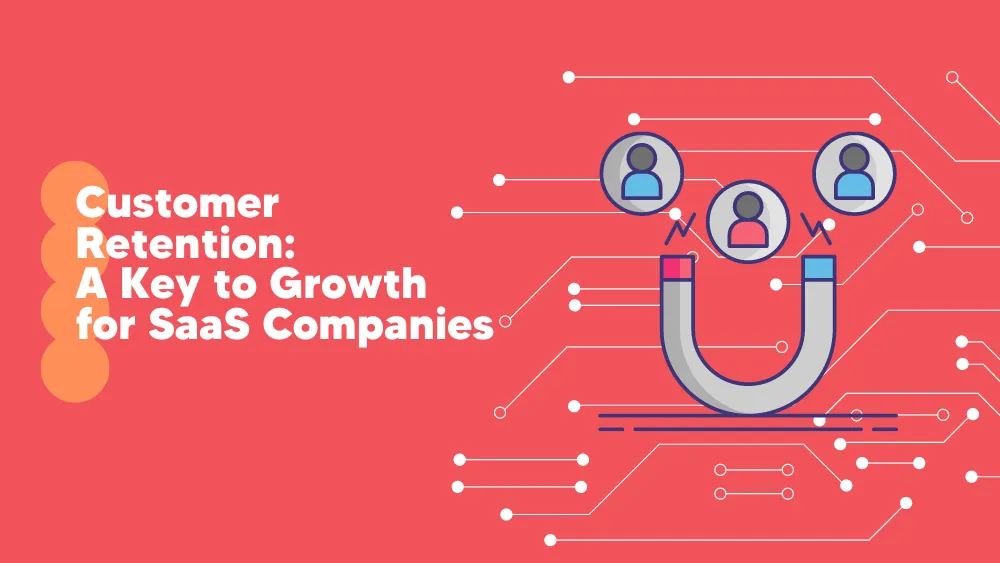In the SaaS universe, getting customers to sign up for your service feels like launching a rocket into space. It’s extremely exciting when everything works, but what happens after the launch? That initial excitement has to be turned into a long-term relationship somehow, and that’s where customer retention comes in, the gravity that keeps your customers orbiting around your business. In this article, we’re not just reaching for the stars; we’re making sure we stay among them.
What is Customer Retention?
Of course, before we dive any further, we should talk about what is customer retention. It is all about taking care of the relationships you have with your customers after they’ve signed up so that they don’t leave and instead continue to use your product (and pay for it). But it’s not just about having them on your subscriber list; it’s about making them happy and helping them find value in your service so that they wouldn’t even dream of going anywhere else.
It’s not just about the revenue too (although that’s definitely important), but also about the value of a loyal customer base. Those who stick around tend to become advocates for your brand, spreading the word to others and contributing to your growth. So, as much as the acquisition is a must, customer retention is the true secret to every thriving SaaS company.
Why Customer Retention is Important for SaaS Companies
The High Cost of Acquiring New Customers
Think about how much effort and resources go into gaining a new customer. That’s quite a lot, right? The general idea is that it costs up to five times more to get a new customer than to keep an existing one. Quite a difference – and it’s just to get them to make their first purchase. This shows why focusing on existing customers, not just new ones, is key for your bottom line.
Creating Brand Advocates
Loyal customers are much more likely to become advocates for your brand. These are the folks who will sing your praises, recommend your product to their networks, and essentially provide free advertising. This word-of-mouth marketing is priceless asiIt not only brings in new customers but does so without the usual acquisition costs.
The Lifetime Value of a Customer
When we talk about the ‘lifetime value’ of a customer, we’re not just talking about their first purchase. We’re talking about all the purchases they make over time. It’s all the subscription fees they pay, as well as all the additional services they might pick up along the way. It’s a long-term relationship that can really add up. If they stick with your service for years, that’s a consistent flow of revenue coming in. When you add up the lifetime value of all your customers, the total can be a real boost for your business.
The Impact of Churn on Revenue and Growth
Churn is industry speak for the rate at which customers stop using your service. High churn rates can throw a wrench into your revenue and put a major roadblock on your path to growth. Every customer that leaves is not just a loss of potential future earnings but also a reminder of the resources spent on acquiring them. We want to keep that churn rate as low as possible.
Predictable Revenue Stream
Another major plus of customer retention is the predictability it brings to your revenue stream. When you retain customers, especially in a subscription-based model, you have a clearer idea of what your future revenue will look like. This certainty makes planning and investing in growth much easier and less risky. It’s the kind of financial stability that every company craves.
Top Customer Retention Strategies
-
Exceptional Customer Service
Exceptional customer service isn’t just about answering questions when they come up. It’s about being proactive, reaching out before there even is an issue, and making sure your customers know that you’re there for them. It’s about solving problems before they even become problems. In an environment, where customers might never meet a representative from your company face-to-face, this can really set you apart.
-
Personalized Experiences
No one likes to feel like just another number. Personalizing the customer experience can make them feel seen and appreciated. This could be as simple as using their name in communications or as complex as tailoring what they see based on their behaviors and preferences. Either way, personalization can make your customers feel special and increase their loyalty to your brand.
-
Loyalty Programs
People simply love being rewarded for their loyalty. That’s why implementing a customer loyalty program can be a fantastic way to keep them coming back. It’s worth thinking about coming up with some rewards for renewing their subscription, referring new customers, or simply as a thank you for their continued support. It’s a small gesture that can have a big impact in the future.
-
Regular Email Newsletters and Updates
Staying in regular contact with customers can make them feel connected to your brand with something more than a regular flow of money. Sending out regular email newsletters and updates can keep them informed about what’s going on with your company and how your product is evolving. Plus, it’s another way to add a personal touch.
-
Educational Resources and Training
Sometimes, customers leave because they don’t understand how to get the most out of a product. By providing educational resources and training, you can ensure that everyone is getting the full value of the service. Not only does this unlock the full potential of the product making it more valuable to the customer, but it also shows that you’re invested in their success.
-
Measuring Customer Retention
At this point, we hopefully all know what customer retention is all about, but how to really check if one’s doing a good job? As the old saying goes, “What gets measured, gets managed,” and that’s where the metrics come in, quite a few of them.
-
Churn Rate
It is like your company’s pulse, ticking away in the background. It’s the percentage of your customers who stop using your product over a given time frame. If it’s low, that’s great news! It means your customers are sticking around. But if it’s high, it’s a clear sign that you need to figure out why your customers are leaving and what you can do to make them stay.
To calculate it, you’ll need to choose a period—for example, a month or a year. Then, divide the number of customers you lost during that period by the number of customers you had at the beginning of the period. Multiply the result by 100 to get a percentage. That’s it.
-
Customer Lifetime Value (CLV)
Customer Lifetime Value, or CLV, is a big-picture metric. It’s all about how much value a customer brings to your business over the whole span of their relationship with you. The higher it is, the better. It means your customers are sticking around for longer and bringing in more revenue over time. If you’re seeing high CLVs, give yourself a pat on the back because your customer retention strategies are working.
Calculating CLV involves a bit of math. First, calculate the average purchase value by dividing your company’s total revenue in a time period (say one year) by the number of purchases during that same period. Then, calculate the average purchase frequency rate by dividing the number of purchases by the number of unique customers who made purchases during that period. Multiply these two numbers to get customer value.
Then, calculate the average customer lifespan by averaging out the number of years they continue purchasing from your company. Finally, multiply customer value by the average customer lifespan to get CLV.
-
Customer Satisfaction (CSAT) Score
This one is a pretty straightforward measure. It tells you how happy your customers are with your product or service. If your CSAT scores are high, that’s a clear sign that you’re doing a great job meeting your customers’ needs. If they’re low, it’s time to figure out how you can better serve your customers and boost their satisfaction.
CSAT is often measured through surveys. You ask your customers to rate their satisfaction with your product or service on a scale of 1-5 (1 being very dissatisfied and 5 being very satisfied). To calculate the score, take the number of satisfied customers (those who responded with a 4 or 5) and divide by the total number of responses. Multiply by 100 to get a percentage.
-
Net Promoter Score (NPS)
Net Promoter Score, or NPS, takes customer satisfaction one step further. It’s not just about whether your customers are satisfied; it’s about whether they like your product so much that they’d recommend it to others. High NPS scores are a really good sign. They show that you’re not only keeping your customers happy but also turning them into advocates for your brand.
NPS is also calculated through survey data. The survey asks one simple question: “On a scale of 0-10, how likely are you to recommend our company/product/service to a friend or colleague?” Responses are grouped into Detractors (0-6), Passives (7-8), and Promoters (9-10).
Subtract the percentage of Detractor responses from the percentage of Promoter responses to calculate your NPS. Note that NPS can range from -100 (if every customer is a Detractor) to 100 (if every customer is a Promoter).
Case Studies
-
Slack: Exceptional Customer Service and Education
Slack is a model example of a SaaS company using customer service and education as a pillar of customer retention. Their commitment to ensuring customers feel supported and informed starts with their robust Help Center. It’s a treasure chest of information, with detailed articles, guides, FAQs, and video tutorials covering every corner of their platform.
But they don’t stop there. They have also implemented in-app guidance, so new users receive helpful tips as they navigate the platform for the first time. This helps new users quickly get up to speed and start leveraging the full capabilities of the software, which in turn improves their overall satisfaction and likelihood of sticking around.
In essence, by investing heavily in customer education, Slack has been able to reduce friction and confusion, two significant factors that can lead to churn. This focus has helped them keep their churn rate in check and maintain a strong, loyal customer base.
-
Adobe and its Transition to Subscription Model
In the early 2010s, Adobe decided to shake things up a bit with the introduction of Adobe Creative Cloud, emphasizing the importance of modifying business strategies for sustaining customer relationships. Before this change, They were selling their software products, like Photoshop and Illustrator, as one-off purchases.
However, this approach presented a problem when it came to offering long-lasting value to their customers, a crucial element for retaining clientele. Adobe Creative Cloud’s introduction marked a transition to a subscription-based model, offering a perfect solution.
This wasn’t just a minor tweak—it was a fundamental shift in how they did business. Adobe went from selling products to building long-term relationships with its customers. And it made a world of difference in keeping their customers on board and happy.
Conclusion
Customer retention is not just the lifeline of a SaaS business; it’s the propelling force that launches the company into the far reaches of success. It’s an intricate dance of providing exceptional customer service, personalizing experiences, implementing loyalty programs, maintaining regular communication, and offering educational resources. All these strategies are geared towards one vital goal: keeping customers happy, loyal, and, ultimately, your biggest advocates.
From the metrics we measure like churn rate, Customer Lifetime Value (CLV), Customer Satisfaction (CSAT) score, and Net Promoter Score (NPS), we see that every interaction, every service touchpoint, and every added value counts towards building a lasting relationship. Companies like Slack and Adobe have shown us how pivoting strategies and focusing on customer success can dramatically reduce churn and drive growth.






